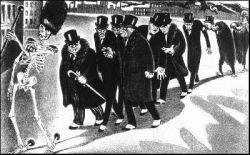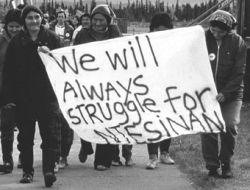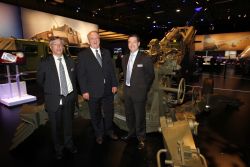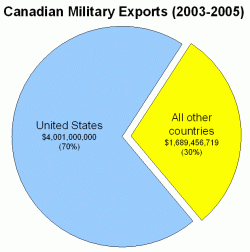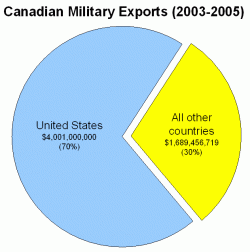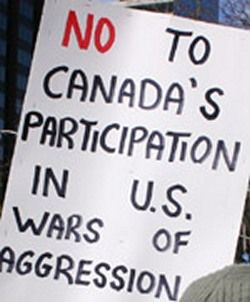HALIFAX (June 25, 2011) – While Canada keeps bombing Libya and killing civilians in the name of “humanitarianism” and the Harper Government has announced a $56 million budget cut to the Department of Fisheries and Oceans, eliminating the Marine Rescue Centre in St. John’s and putting the lives of civilians at sea in peril, it is spending hundreds of thousands of dollars to send arms manufacturers to the International Paris Air Show.
The Paris show is held every two years and alternates with the Franborough International Airshow in the United Kingdom. The 49th edition is being held at the Le Bourget airport in Paris’ gritty northern industrial suburbs on June 20-26. The Bourget Salon is the sales convention for today’s “Merchants of Death.” The name comes from the stark title of a book of the same name, referring to those such as Vickers (now BAE Systems of the UK, the second-largest weapons manufacturer in the world), du Pont of the USA, Krupp of Germany, and Schneider-Creusot of France who sold munitions to both sides in the First World War, and other wars, while securing a special place as the greatest patriots in the “national” economy. Some 2,000 exhibitors are peddling the most recent lethal creations. It is the largest arms bazaar in the world, resulting in more than US$89 billion in contracts in 2008, more than double the 2006 sales. A Fox News report three years ago claimed that the booth for Israel, now the 5th largest weapons manufacturer in the world, boasted the most scantily-clad women carrying weaponry that Israeli arms companies and the Israeli government hoped to sell in the international market. The Canadian Pavilion, financed and staffed by the government, is a fixture.
A total of 15 firms, agencies and military associations from Atlantic Canada alone are once again taking part in the show, the Federal Service for Military-Technical Cooperation says.
However, there is more to this than meets the eye. Participants include the NDP government of Nova Scotia’s little-known Aerospace, Defence & Security section and the more well-known Nova Scotia Business Inc., the government’s joint venture arm to pay the rich by providing subsidies and forgivable loans from the public treasury to private capital and a co-sponsor of DEFSEC Atlantic, the annual arms show which will be held September 7-9 in Halifax.
The retinue also includes Dalhousie University’s little-known Industry Liaison & Innovation centre (located at 1379 Seymour Street). The university is deeply implicated in providing arms monopolies such as Lockheed Martin and the Department of National Defence with research, training and development at little or no cost, one of the main sources of profits for capital at this time -- giving the meaning to Dalhousie’s “inspiring minds” slogan and the mantra of the “knowledge economy.”
“Freedom”?
By far the most perfidious aspect of the sales force is that it includes DND International Training Programs (Goose Bay) (pictured), a euphemism to huckster the de facto NATO base in Labrador, which has been vehemently opposed by the Innu Nation of Labrador since the 1950s. The DND slogan is -- wait for it -- “the freedom to fly.” (Look again at the picture!) The venality goes well beyond hypocrisy: “freedom” for NATO war preparations and “freedom” to forcibly negate the freedom of the First Nations and their hereditary rights.
The Department of National Defence maintains an aerial testing area (and Arctic survival training) for such NATO Air Forces as Britain and Germany as well as the Italian army, and annually uses the Paris Air Show to shop it to other members of the NATO bloc at the expense of the First Nations. The hereditary territory of the Innu is used as a base for imperialist war preparations, which the whole world is witnessing now being executed against Libya -- just as the Israeli pilots who bomb Gaza to smithereens in were trained in Alberta (Operation Maple Leaf, CFB Cold Lake). The land of the Innu is again being sold in the service of realizing what Defence Minister Peter MacKay brazenly calls Canada’s “go to” role for the U.S and the NATO bloc.
In the mid 1980s, the Innu Nation of Labrador and Eastern Quebec (Nitassin) held a compelling series of protests (pictured), vigorously supported Canada-wide, against the military’s plan to conduct low-level flight testing and laser-guided bombing in central and southern Labrador, which greatly increased in the number of flights in the early 1990s. The bombing caused havoc to the environment, scattering the reindeer herds to the four winds, and their way of life. After failing to secure their goals through environmental assessment reviews, political lobbying, and the courts, the Innu took direct action. They physically occupied runways on military bases in Labrador to protest low-level flying, only to face mass arrests by the Canadian government. [1]
Yet despite the state’s best efforts, including the persecution of the courageous Innu and the suppression of their heroic protests, it failed to secure its cherished designation of Goose Bay as the NATO flight training centre, which instead went to Italy; instead of closing the facility, Harper shops it in the back alleys of NATO and the Paris air show like a discount car rental at the airport; three days, bargain rate, first 100 kilometres free, complete with insurance -- “freedom to fly,” the “go to” deal.
“Atlantic Canada Opportunities”
From the foregoing it is clear that it is the Government of Canada, financier and organizer of the Canadian Pavilion in Paris and Farnborough, that is the main “lobbyist” or instrument for the arms industry. In 2010 two of Harper’s ministers attended, Jim Flaherty, minder of the budget, and Keith Ashfield (Minister for ACOA and the Atlantic Gateway, pictured), as well as cabinet ministers from each of the Atlantic provinces, including Percy Paris, NDP N.S. Minister of Economic Development and the Atlantic Gateway project (pictured). How many Canadian generals, admirals, high commissioners, provincial cabinet ministers and Julian Fantino’s are attending this year’s inauguration of new deadly machinery in the French capital is not known, but the head “lobbyist” at this year’s arms show is Christian Paradis, Minister of Industry.
In Atlantic Canada alone (through the Atlantic Canada Opportunities Agency [ACOA]), the Harper Government is providing $154,652 -- or just over $10,000 for each “delegate” -- through its Business Development Program to Aerospace Prince Edward Island Inc. (APEI) as its regional partner -- on behalf of the Atlantic Alliance of Aerospace and Defence Associations (AAADA) -- in assembling what it calls “this business mission.” These associations, and others across Canada such as the Canadian Association of Defence and Security Industries, organizer of the annual Ottawa arms show (CANSEC), include all the industries linked to the production of technologies or weapons for whom wars of occupation such as in Libya, Iraq and Afghanistan or the increased surveillance of people are looked upon as business opportunities. This practice of transferring public money to certain private associations and privileged monopolies of the rich must stop.
ACOA, in partnership with APEI organizes the delegation’s attendance at the show. The ACOA budget also takes care of the Halifax International Security Forum (known as the Halifax War Conference, pictured) in November with some $2.5-million annually. Organized by the Department of National Defence and the Washington-based German Marshall Fund, it was attended by no more than 300 U.S., NATO and military representatives, under the pretext of making Halifax “a destination centre.” Almost as many Haligonians demonstrated outside. That sum represents twice what Nova Scotia spends on literacy each year, and an average $8,333.00 for each individual militarist at the Westin Hotel. Then there is the red carpet for its “keynote speakers” -- war criminals such as Condoleeza Rice of the Bush administration and Gen. Ehud Barak of Israel who demand more than the average rate. Another $507,000 flowed from ACOA to found the office for the Atlantic Gateway project. “Atlantic Canada Opportunities” is now synonymous with the militarization of the economy and the global preparations for trade war, the precursor to war.
In light of the revelations of the envelopes of money received by former Prime Minister Brian Mulroney, and the shady role of the Mackays as middlemen, for promoting “peace” on behalf of arms manufacturers and shipbuilders such as Thyssenkrupp in the form of arms peddling, people have the right to ask just what are these “lobbies” all about?
ACOA awards its subsidy for participation in the international arms show on an annual basis. APEI is not only a military-industry association but itself can also be called a so-called “lobby group,” and is one of four such groupings just from this region being financed by ACOA for the Paris junket (see complete list in appendix). These cliques carry closed-door negotiations to push the Harper agenda in military spending, fixing of prices including labour, securing contacts and subcontracts, delimiting markets throughout their industry, export regulations and crushing their rivals or taking them over, in order to benefit its corporate members. It illustrates once again how the state has been reduced to being the main instrument of the most powerful arms monopolies and the financial oligarchy such as the bankers who always have the final say, rather than the so-called “lobbyists” either registered (e.g., Hill and Knowlton) or unregistered (e.g., whether they go by Dexter, Clark, Charest or any other name).
How can anyone believe the nonsense that this is for “jobs”, “Olympic”-scale “regional benefits” or humanitarian ideals when Paris shows all over again how our so-called political representatives prostrate themselves before one of the most powerful and most dangerous “lobbies” in the world? Is this not the essence of the current diversionary propaganda over the militarization of shipbuilding, with the Harper government claiming an “arms length” distance to fool the gullible and to justify calling its neo-liberal contract system as “fair and transparent,” based on “merit,” and above mere influence-peddling? [2] These feudal groupings are heavily financed by Ottawa and provincial governments; in other words, the practice of closed door negotiations has also been finessed and these vested interests have become an unofficial part of the Canadian government. The fact that it is the state which is the lobbyist and the tool while Canadians are at mercy from forces out of their control and out of sight but have nonetheless courageously resisted is left in the shade. There is no better way of describing a “conflict of interest” as when such political representatives are prepared to violate the sovereignty of the country in such a way.
If this is what is being spent in the poorest region of Canada, one can only imagine how much is being transferred by the Harper and provincial governments in each region across Canada to the military monopolies and their cartel associations so they can aim for the big score in the battlefield of seedy dealings at the Paris arms show and other events. Paradis gleefully announced from Paris that as of June 21st, “Canadian companies have already announced more than $2.2 billion in new and projected business, which is a testament to Canada’s world-class talent and global reach.” Over half of this sum is credited to two monopolies, Bombardier, a global monopoly which now has much of its operations outside Canada, and Lockheed Martin, that other famous Canadian success story who now manages the Canadian census on behalf of Statistics Canada.
Business as usual but more than the usual business
This majority Harper government defies the broad desire of Canadians for Canada to be a force for peace in the world, but its megalomania is such that it preens itself as the chief cock on the walk as “a global leader.”
Without any shame, Paradis boasted in his statement, “Our government has been given a strong mandate to implement the next phase of Canada’s Economic Action Plan”. “We take pride in Canada’s aerospace sector and expect that it will remain a global technology leader and a major source of high-quality jobs.” Sixty one per cent of Canadians voted against this government and gave it no such “strong mandate” to militarize the economy as “a global leader.”
A few figures will give an idea of the direction of the military-defence industry in Canada and the scope of destruction. The Coalition Opposed to the Arms Trade (COAT) points out that the vast majority of Canadian arms are sold to the United States, which receives 70 per cent or more of military exports (see chart, pictured). [3]
Between 2003 and 2004 for example, Canada exported arms to 73 nations, 39 of which had troops that were then engaged in major military conflicts, either at home or abroad. This means that 53 per cent of the countries to which Canada exported military goods during those three years, were directly engaged in wars, invasions and/or occupations.
The United States itself controls nearly 40 per cent of the global arms trade, a $60 billion yearly business. Most of the trade – $45.1 billion – focuses on developing nations, with just one country alone, U.S.-occupied Iraq, being forced to purchase $13 billion in U.S. weaponry, one third of the total. All are countries struggling with poverty, exploitation and domination.
In 2008 the U.S. cornered 68.4 per cent of such sales to the developing world, but this declined to 45.1 per cent in 2009, indicating the fierce inter-monopoly and inter-imperialist struggle on this front, a factor for war.
In Paris, Paradis met with “prime contractors” of Lockheed Martin’s F-35 stealth jet “to discuss Canada's role in the development of the aircraft and also met with a number of Canadian suppliers that are benefitting from F-35 work.”
He then added: “With approximately US$350 million in secured contracts for work on the F-35 aircraft, Canadian technologies are being embedded in the aircraft's fleet of over 3,100 planes for partner countries -- well beyond the 65 planes that the government is purchasing.”
Three thousand and one hundred military jets. In other words, not only is the Harper government buying fighter jets for Canada with a contract that was never tendered, it is strengthening Lockheed Martin generally in its battle with monopoly competitors in other NATO countries in all its areas of business including the designing and building of fighter aircraft, and is actively building the U.S. Empire and the export market for arms and technologies produced by the monopolies based in Canada.
In the same direction, these empire-builders plan to export throughout the world the design and components in the forthcoming Joint Support Warships -- 60-70 per cent of the value of which is represented by foreign armaments and electronic systems -- by bypassing U.S. export restrictions on Canadian military production by U.S. subsidiaries.
The lucrative sales of these “new” and “Canadian” systems are to be aimed at countries such as the U.S. client state of South Korea, which has developed its own shipyards capable, like Canada, of assembling hulls of warships but not the modern weapons and electronic systems which the big powers monopolize. Modern, militarized shipbuilding and military superiority in the sea and the air with bigger naval fleets or better fighter planes and missiles is crucial at this time for U.S. Empire-building. The offensive against Libya and North Africa shows that advanced weaponry, based at sea or in the air or space, is needed to overcome the superior numbers, determination and resistance of the oppressed peoples and the targeted states. The Canadian military would not last one day in Afghanistan without superior weapons and U.S. air support. Participation in events such as the international Paris arms fair can only result in Canada providing greater assistance to U.S. state terrorism in the form of direct military invasions, U.S.-backed coups, or attacks by U.S. allies on the peoples of the world.
We are not for sale
An imperial prime minister increases military expenditure while reducing social spending. The budget of the Department of Fisheries and Oceans is being slashed by $56 million and the oceans are being corporatized and privatized: as I raised during the election, prosecutions of foreign-owned oil tankers for oil spills and the degradation of the ocean has been slashed by Canada over the past ten years to a third.
According to Newfoundlanders, the elimination of the Marine Rescue Centre in St. John’s and its Search and Rescue sub-station threatens the lives and security of fishermen, seafarers and workers on the oil rigs. In Paradis’ language, these must be “low-quality jobs” – collateral damage to “economic recovery.” And what does the mass media have to say about these grim realities? Nothing. However, they have lots of praise for the deadly arsenal assembled by the U.S. and NATO as brazenly exemplified by the Halifax Chronicle Herald, which once again openly called for regime change in Libya and assassination, “the ouster of Gadhafi’s clique,” and “effect[ing] change on the ground,” i.e., invasion (Extending mission right tack on Libya, June 20, 2011). In the battle to influence the populace on behalf of the arms industry, the editorial merchants of death on Joseph Howe Drive always have their eye on expanding the market; war scares, fake atrocities and simplistic terrorist sightings are all grist in the mill to inflame tension at the expense of the world’s peoples, which the proud provincial patriots justify with the slogan of “making Nova Scotia competitive.”
Well, Newfoundlanders have a lot to say about “effect[ing] change on the ground” – and were saying it this Saturday, June 25, at a major rally on the St. John’s waterfront at the foot of Prescott Street (just east of Atlantic Place). Said the Fish Food & Allied Workers:
“Come by boat if you can. We need a good show of support from fishing vessels in the harbour. If you can’t come by boat, show up on the waterfront.
“Let’s send a message to the Harper Government – our safety at sea is not for sale. They should be improving Search and Rescue services, not watering them down.”
Over 2,000 Newfoundlanders and not a few boats responded. This shows an alternative. We must replace old, worn-out notions of “security” and “defence” with modern definitions which are alive and transforming and which actually enable people to sort out the problems of the real world. The safety, security and future of Canadians does not lie with war preparations, militarization, and the U.S. and NATO bloc. Canadians and Canada are not for sale. This reaffirms that our security lies in our fight for the rights of all, a struggle that we must intensify.
In the midst of a global financial and economic crisis -- along with protest, actions and other forms of resistance -- Canadian workers have put forward the demand Manufacturing Yes! Nation-Wrecking No! This is a political demand, which includes ending war production which has no social or economic value whatsoever. It results in one section of the international working class creating the means to destroy another, while further enriching the bourgeoisie. In reality, military spending doesn’t create jobs, it kills them. Labour and it allies must explore ways and tactics to take these industrial works out of the hands of the monopoly wreckers and put them into the hands of the people and government, to become part of an all-sided self-reliant socialized economy serving all regions of the country.
Canadians have put forward the political demand to stop paying the rich and increase funding for social programmes. It is equally unacceptable that the Canadian government has abdicated its duty to provide for the immediate needs of the working class, fishermen and seafarers for social programs to sustain them, the economy and the society, while it advocates arms production and war and criminalizes their struggles to defend their demands with back-to-work legislation. To hold Harper and his war government to account we need to practically organize for an anti-war government -- not as some distant prospect but as an immediate need.
Down all Canadian involvement in U.S. imperialist adventures!
Down with NATO war preparations and training in Labrador and Canada!
Support the Newfoundland fishers and seafarers!
Tony Seed is a Halifax journalist and publisher and maintains a blog of his writing and related work at http://tonyseed.wordpress.com
Endnotes
1. “Stop NATO bombing over Labrador!,” TML Daily, December 21, 2001
2. “Harper battles lobbyists on shipbuilding strategy; Lobbyists angry at snub during RFQ process,” Canadian Press, June 10, 2011
3. Richard Sanders, Coordinator, Coalition to Oppose the Arms Trade, “Canadian Military Exports to Countries at War, 2003-2005,” TML Daily, May 26, 2009 – No. 104
4. Stew Magnuson, “East-West divide grows in the international nay shipbuilding business,” June 2011, National Defense Industrial Association
Facts on file: Canada and the arms trade
Between 2003 and 2005, Canada exported more than $5.6 billion in military exports to 73 countries. Of these 73 nations, 39 had troops that were then engaged in major military conflicts, either at home or abroad. This means that 53 per cent of the countries to which Canada exported military goods during those three years, were directly engaged in wars, invasions and/or occupations.
However, much more significant is the fact that these 39 warring nations receiving Canadian military hardware accounted for a full 90 per cent (i.e., $5.1 billion) of the total value of Canada’s military exports between 2003 and 2005. As mentioned above, the United States received 70 per cent or more of military exports in the period studied by COAT. For example, Canadian exports to the U.S. account for:
- 79 per cent of Canada's military exports to countries deployed in Afghanistan;
- 81 per cent of Canada's military exports to countries deployed in Iraq; and
- 92 per cent of Canada's military exports to countries deployed in Haiti.
The Coalition to Oppose the Arms Trade points out: “Canada is thoroughly and completely integrated into the military industrial complex as part of the “North American Military Industrial Base.” As such, the U.S. government treats Canadian companies as if they were U.S. companies. The Canadian government requires exporters to procure military export permits for all foreign sales except for military exports to the U.S. The complete lack of trade restrictions on Canadian military exports to the U.S. (with the exception of ships, which are banned from the U.S. market under the Jones Act) also means that the Canadian government has been free to hand out billions of dollars in grants and loans to Canada’s already highly profitable war industries. Under Canada-U.S. trade agreements, such subsidies are not permitted except in military and energy sectors. The Pentagon is therefore free to take advantage of publicly-subsidized Canadian military products in all of its wars, invasions, interventions, regime changes and bombing operations.
According to Parais, “Canada's aerospace industry is a key contributor to the economy and, according to the Aerospace Industries Association of Canada, it generates annual revenues of $22 billion and employs nearly 80,000 Canadians in high-paying jobs at more than 400 firms.” Canada boasts the fourth-largest aerospace industry in the world.
The militarization of the economy of the Maritimes is assuming major proportions. Between 2001 and 2010, A&D exports grew by 231 per cent, generating over $1 billion in annual revenue. According to a news release from ACOA, “Atlantic Canada’s aerospace and defence firms collectively employ over 10,000 skilled and experienced workers, including a wide range of suppliers that provide globally-competitive solutions and support to both military and commercial markets, here and abroad.”
The Website of DEFSEC Atlantic notes for its September 2011 show in Halifax that “the exhibition floor is now sold out” ... “as we present another outstanding collection of government procurement officials, industry leaders in original equipment manufacturing, global systems integrators and dozens of supply chain participants who make this complex industry work.” The keynote session features “emerging challenges and industry opportunities in the Marine Industries & Shipbuilding field.”
* * *
Maritime companies and agencies at the Paris arms shows
Prince Edward Island
Aerospace Association of Prince Edward Island (APEI)s
The Atlantic Alliance of Aerospace and Defence Associations (AAADA)
3 Points Machining & Aerospace (Charlottetown)
Marand Engineering (Charlottetown)
New Brunswick
New Brunswick Aerospace & Defence Association (NBADA)
· APEX Industries (Moncton)
Moncton Flight College (Moncton)
Newfoundland and Labrador
Aerospace & Defence Industry Association of Newfoundland & Labrador (ADIANL)
Bluedrop Performance Learning (St. John’s)
DND International Training Programs (Goose Bay)
Provincial Aerospace Ltd. (St. John’s)
Nova Scotia
Aerospace & Defence Industries Association of Nova Scotia (ADIANS)
· Composites Atlantic Limited (Lunenburg)
Dalhousie University (Halifax)
· Deep Vision (Dartmouth)
· IMP Aerospace (Enfield)
